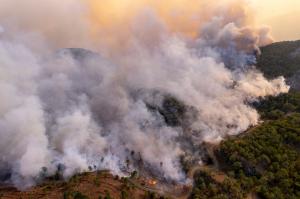Systems Technology, Inc. Unveils Innovative Solutions to Strengthen Firefighting Efforts Amid Growing Wildfire Threats
The Growing Challenge of Wildfires
In recent years, the frequency and severity of wildfires have reached alarming levels, particularly in California. In 2024, the National Interagency Fire Center (NIFC) reported more than 50,000 wildfires across the U.S., which burned an estimated 7.3 million acres. The destructive consequences of these fires are far-reaching, costing lives, displacing communities, and causing significant economic damage.
Earlier in 2025, the Los Angeles wildfires burned more than 50,000 acres, threatening hundreds of homes and businesses in one of the largest urban areas in the U.S. The event emphasized the urgent need for advanced solutions to help manage and fight these unpredictable, destructive fires. Several key challenges for firefighters were noted, including navigating rugged terrain and the complexity of coordinating multiple units and responding agencies.
STI’s Vision for the Future of Firefighting
In response to these challenges, STI is rolling out a new series of projects aimed at improving firefighting practices. The company’s solutions will leverage existing firefighting data sources, an innovative and intuitive mapping interface, and a robust mesh-radio network to improve situational awareness, enhance communication, and enable more effective resource deployment during fire events.
"Our goal is to provide firefighters with the real-time tools they need to make quicker, safer decisions. By improving communication and situational awareness, we can help them respond more effectively to the growing wildfire threat.” -- Elliot Seguin
Key Projects and Technology Solutions
STI’s new initiative will include the following innovative solutions:
* Intuitive and robust mapping and interface overlays
* Small-form factor mesh radio network hardware suitable for UAS, piloted aircraft, and ground crew alike to enable robust communication and data networks
* Flexible data ingestion methods that include external databases, and user generated artifacts
* Automated capture of retardant / water drops and fire break lines
* Airspace picture that captures both piloted aircraft and UAS particulars
Expected Outcomes and Benefits
With these technological advancements, STI aims to achieve several key outcomes:
* Enhanced Safety: Reducing the risk to firefighters by providing real-time intelligence
* Faster Response Times: Firefighters will have the tools to make faster, more informed decisions, enabling a more efficient response
* Improved Resource Allocation: Allow firefighting teams to better allocate resources where they are most needed, optimizing manpower and equipment use
* Integrated Response Teams: Provide a method to track both piloted aircraft and UAS (cooperative or otherwise) in the airspace including capturing retardant / water drop targets and actual drop locations
As part of its ongoing commitment to innovation and community safety, STI is collaborating with fire departments, government agencies, and other stakeholders to refine these technologies.
About STI
We empower people to safely operate complex systems. With nearly 70 years of expertise in human-machine interaction, STI's research-backed solutions enhance assessment, training, and human performance across aerospace, defense, and clinical applications.
Sanjeev Weerasuriya
Systems Technology, Inc.
+1 310-897-6799
news@systemstech.com
Legal Disclaimer:
EIN Presswire provides this news content "as is" without warranty of any kind. We do not accept any responsibility or liability for the accuracy, content, images, videos, licenses, completeness, legality, or reliability of the information contained in this article. If you have any complaints or copyright issues related to this article, kindly contact the author above.

